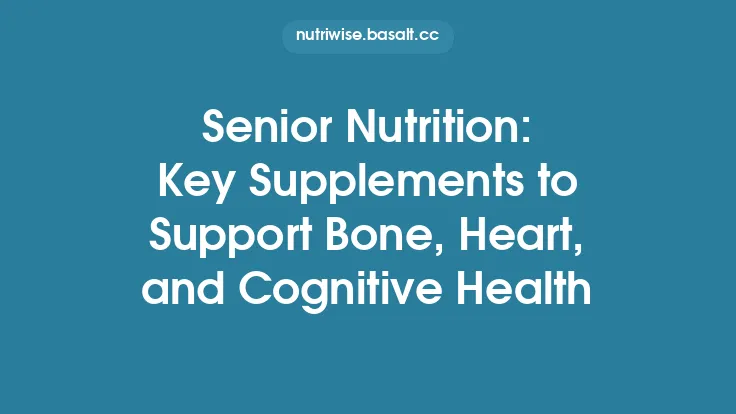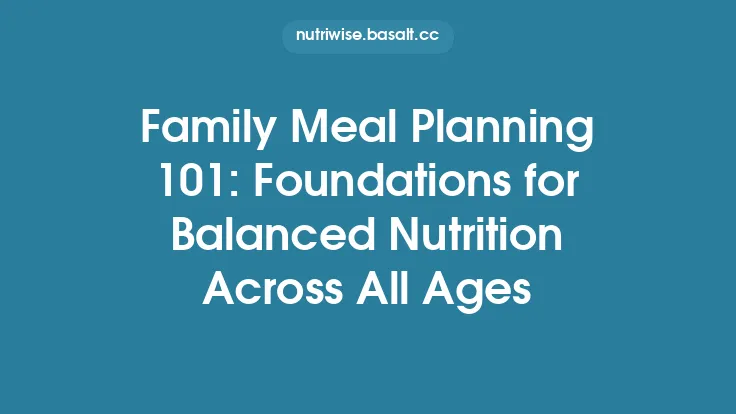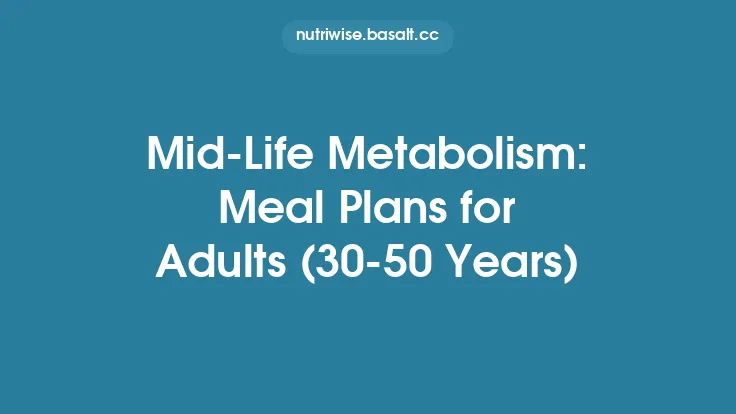Aging brings a natural shift in how the body processes nutrients, and after 65 years the balance of certain vitamins and minerals becomes especially critical for maintaining skeletal strength, preserving cognitive sharpness, and supporting a resilient immune system. While overall calorie needs may decline, the demand for specific micronutrients often rises because of changes in digestion, skin synthesis, renal function, and cellular turnover. Understanding which micronutrients deserve priority, how they work together, and the most reliable ways to obtain them can empower seniors to protect bone density, nurture brain health, and keep the immune defenses robust throughout later life.
Key Micronutrients for Bone Health in Older Adults
| Micronutrient | Primary Role in Bone | Recommended Dietary Allowance (RDA) * | Key Food Sources | Absorption Tips |
|---|---|---|---|---|
| Calcium | Provides the mineral matrix of bone; essential for remodeling cycles. | 1,200 mg/day (both sexes) | Low‑fat dairy (milk, yogurt, cheese), fortified plant milks, sardines with bones, tofu set with calcium sulfate, leafy greens (collard, bok choy). | Split doses (≤500 mg) throughout the day; pair with vitamin D; avoid excessive sodium and caffeine which increase urinary calcium loss. |
| Vitamin D | Enhances intestinal calcium absorption; modulates bone turnover via osteoblast/osteoclast activity. | 800–1,000 IU (20–25 µg) daily; up to 2,000 IU may be needed for deficient individuals. | Fatty fish (salmon, mackerel), egg yolk, fortified dairy/plant milks, UV‑exposed mushrooms. | Sun exposure (10–30 min, mid‑day, face/arms) 2–3 times/week can supplement; vitamin D is fat‑soluble—consume with dietary fat. |
| Magnesium | Cofactor for enzymes that synthesize vitamin D; influences calcium transport and bone crystal formation. | 420 mg/day (men), 320 mg/day (women) | Nuts (almonds, cashews), seeds (pumpkin, chia), whole grains, legumes, dark chocolate. | High dietary fiber can bind magnesium; avoid taking magnesium supplements simultaneously with high‑dose calcium. |
| Vitamin K2 (menaquinone) | Activates osteocalcin, a protein that binds calcium to the bone matrix; helps prevent vascular calcification. | No established RDA; AI ≈ 90 µg (men), 75 µg (women) | Fermented foods (natto, sauerkraut), hard cheeses, egg yolk, butter from grass‑fed cows. | Vitamin K works synergistically with vitamin D; ensure adequate dietary fat for absorption. |
| Phosphorus | Forms hydroxyapatite crystals with calcium; essential for bone mineral density. | 700 mg/day (adequate intake) | Meat, poultry, fish, dairy, nuts, legumes. | Excessive phosphorus (especially from sodas) can disrupt calcium balance; maintain a 1:1 calcium‑to‑phosphorus ratio. |
| Boron | Modulates calcium, magnesium, and vitamin D metabolism; may reduce bone resorption. | No RDA; 1–3 mg/day considered safe | Fruits (apples, pears), nuts, legumes, avocados. | Generally well‑absorbed; excess intake (>20 mg) may affect fertility. |
Why these nutrients matter: After 65 years, bone remodeling tilts toward resorption, accelerating loss of trabecular and cortical bone. Adequate calcium and vitamin D are the cornerstone, but without sufficient magnesium, vitamin K2, and phosphorus, the calcium cannot be effectively deposited. Boron, though less discussed, has emerging evidence for modest improvements in bone mineral density when combined with the core nutrients.
Essential Micronutrients for Cognitive Function and Brain Aging
| Micronutrient | Cognitive Role | RDA/AI | Principal Sources | Notes on Efficacy |
|---|---|---|---|---|
| Omega‑3 fatty acids (EPA/DHA) | Integral to neuronal membrane fluidity; anti‑inflammatory; support synaptic plasticity. | 250–500 mg DHA + EPA combined (no formal RDA) | Fatty fish (salmon, sardines, herring), algae oil, fortified eggs. | Clinical trials show modest benefits for memory and processing speed in seniors with low baseline intake. |
| Vitamin B12 (cobalamin) | Cofactor for methylation reactions, myelin synthesis, and neurotransmitter production. | 2.4 µg/day (higher needs if absorption impaired) | Animal products (meat, fish, dairy), fortified cereals, nutritional yeast. | Gastric atrophy reduces intrinsic factor; sublingual or injectable forms may be required for some individuals. |
| Folate (vitamin B9) | Supports one‑carbon metabolism; deficiency linked to elevated homocysteine, a risk factor for cognitive decline. | 400 µg DFE/day (dietary folate equivalents) | Dark leafy greens, legumes, citrus fruits, fortified grains. | Folate works synergistically with B12; excess folic acid can mask B12 deficiency symptoms. |
| Vitamin E (α‑tocopherol) | Antioxidant protecting neuronal lipids from oxidative damage. | 15 mg (22.4 IU) α‑tocopherol/day | Nuts (almonds, hazelnuts), seeds, spinach, avocado, wheat germ oil. | High-dose supplementation (>400 IU) has been linked to increased mortality; stay within RDA. |
| Vitamin D | Modulates neurotrophic factors; deficiency associated with higher risk of dementia. | 800–1,000 IU/day (see bone section) | Same as bone section. | Benefits appear most pronounced when baseline levels are low (<20 ng/mL). |
| Choline | Precursor for acetylcholine, a neurotransmitter critical for memory. | AI 550 mg/day (men), 425 mg/day (women) | Eggs (especially yolk), liver, soybeans, quinoa. | Adequate intake supports brain health; excessive supplementation (>3.5 g) may cause hypotension. |
| Zinc | Involved in synaptic transmission and neurogenesis; deficiency linked to impaired cognition. | 11 mg/day (men), 8 mg/day (women) | Oysters, beef, pumpkin seeds, chickpeas. | High zinc can interfere with copper absorption; keep within RDA. |
Mechanistic insight: The aging brain experiences increased oxidative stress, reduced neurogenesis, and vascular changes. Micronutrients that support methylation (B12, folate), membrane integrity (omega‑3s, vitamin E), and neurotrophic signaling (vitamin D, choline) collectively help preserve neuronal function and slow age‑related cognitive decline.
Immune‑Supporting Micronutrients for Seniors
| Micronutrient | Immune Function | RDA/AI | Food Sources | Practical Tips |
|---|---|---|---|---|
| Vitamin C | Enhances barrier integrity, supports leukocyte function, acts as an antioxidant. | 90 mg (men), 75 mg (women) – higher intakes (200–500 mg) often recommended for older adults. | Citrus fruits, berries, kiwi, bell peppers, broccoli. | Vitamin C is water‑soluble; split doses throughout the day to maintain plasma levels. |
| Vitamin D | Modulates innate and adaptive immunity; deficiency linked to increased infection risk. | 800–1,000 IU/day (see bone section) | Same as bone section. | Adequate levels (>30 ng/mL) correlate with reduced respiratory infections. |
| Zinc | Crucial for thymic hormone production, lymphocyte proliferation, and antiviral activity. | 11 mg (men), 8 mg (women) | Same as brain section | Avoid taking zinc on an empty stomach if it causes nausea; pair with protein. |
| Selenium | Component of glutathione peroxidases; protects immune cells from oxidative damage. | 55 µg/day | Brazil nuts (1–2 nuts provide >100 % DV), seafood, eggs. | Excess selenium (>400 µg) can be toxic; limit to 1–2 Brazil nuts per day. |
| Iron | Required for proliferation of immune cells and generation of reactive oxygen species used to kill pathogens. | 8 mg/day (men), 8 mg/day (women) – note that many seniors have adequate stores; excess iron can be harmful. | Lean red meat, poultry, lentils, fortified cereals. | Assess ferritin before supplementing; avoid high‑dose iron unless deficiency is confirmed. |
| Vitamin A (retinol & β‑carotene) | Supports mucosal surfaces and differentiation of immune cells. | 900 µg RAE (men), 700 µg RAE (women) | Liver, carrots, sweet potatoes, dark leafy greens. | Preformed vitamin A (retinol) should not exceed 3,000 µg/day to avoid toxicity. |
| Copper | Works with iron to maintain immune cell function; deficiency impairs neutrophil activity. | 900 µg/day | Shellfish, nuts, seeds, whole‑grain products. | Balance with zinc; high zinc intake can induce copper deficiency. |
Why seniors need more: Age‑related thymic involution and reduced production of naïve T‑cells diminish immune responsiveness. Micronutrients that bolster barrier defenses, antioxidant capacity, and lymphocyte function become increasingly important to offset this natural decline and to reduce susceptibility to infections such as influenza and pneumonia.
Interactions, Absorption, and Bioavailability Considerations in the 65+ Age Group
- Gastrointestinal Changes – Gastric acid secretion wanes (hypochlorhydria), impairing the release of minerals from food matrices. This particularly affects calcium, iron, zinc, and vitamin B12 absorption. Strategies include consuming these nutrients with a modest amount of acid‑rich foods (e.g., citrus) or using chelated mineral forms.
- Vitamin D–Calcium Synergy – Vitamin D status directly influences calcium absorption efficiency. Without sufficient vitamin D, even high calcium intakes may not translate into bone deposition.
- Magnesium–Vitamin D Interplay – Magnesium is required for the hepatic and renal conversion of vitamin D to its active form (calcitriol). Low magnesium can blunt the effectiveness of vitamin D supplementation.
- Vitamin K–Vitamin D Antagonism – While both support bone health, excessive vitamin K antagonists (e.g., high doses of vitamin E) can interfere with vitamin K–dependent carboxylation processes.
- Copper–Zinc Balance – High supplemental zinc (>40 mg/day) can induce copper deficiency, leading to neutropenia and anemia. Maintaining a zinc‑to‑copper ratio of roughly 10:1 is advisable.
- Fiber and Phytate Effects – Diets high in whole grains, legumes, and nuts are beneficial but contain phytates that bind calcium, iron, and zinc. Soaking, sprouting, or fermenting these foods reduces phytate content and improves mineral bioavailability.
- Medication Interactions – Common prescriptions in seniors (e.g., proton‑pump inhibitors, diuretics, bisphosphonates) can affect micronutrient status. PPIs reduce B12 absorption; thiazide diuretics increase calcium reabsorption; bisphosphonates may impair oral calcium uptake if taken simultaneously. Timing supplements away from medication doses (usually 2 hours apart) can mitigate these effects.
Practical Strategies to Meet Micronutrient Needs Through Diet
- Adopt a “Rainbow Plate” – Aim for at least five different colored fruits and vegetables daily. This naturally supplies vitamin C, vitamin A (β‑carotene), folate, potassium, and phytonutrients that support immunity and cognition.
- Incorporate Two Servings of Fatty Fish Weekly – Provides EPA/DHA, vitamin D, selenium, and high‑quality protein. For those who avoid fish, algae‑based DHA supplements are a plant‑based alternative.
- Choose Calcium‑Rich Dairy or Fortified Alternatives – One cup of milk or fortified soy/almond milk delivers ~300 mg calcium. Pair with a source of vitamin D (e.g., fortified cereal) for optimal absorption.
- Snack on Nuts and Seeds – A handful of almonds, pumpkin seeds, or walnuts supplies magnesium, zinc, vitamin E, and healthy fats.
- Include Fermented Foods – Natto, kefir, and sauerkraut contribute vitamin K2 and beneficial probiotics that may indirectly support immune health.
- Plan a Weekly “Bone‑Boost” Meal – Combine a calcium‑dense food (e.g., baked salmon with bones, tofu), a vitamin D source (e.g., fortified milk), and a magnesium‑rich side (e.g., sautéed spinach with sesame seeds).
- Utilize Cooking Techniques that Preserve Nutrients – Light steaming retains water‑soluble vitamins (C, folate) better than prolonged boiling. Adding a splash of olive oil after cooking enhances absorption of fat‑soluble vitamins (A, D, E, K).
- Monitor Hydration – Adequate fluid intake supports kidney function, which is essential for maintaining optimal mineral balance, especially calcium and phosphorus.
When to Consider Supplementation: Guidelines and Safety Tips
| Situation | Recommended Supplement (if needed) | Typical Dose for Seniors | Safety Considerations |
|---|---|---|---|
| Low serum 25‑OH vitamin D (<20 ng/mL) | Vitamin D₃ (cholecalciferol) | 1,000–2,000 IU daily; up to 4,000 IU under medical supervision | Re‑check levels after 8–12 weeks; avoid exceeding 4,000 IU without monitoring. |
| Confirmed calcium deficiency (diet <800 mg/day) | Calcium carbonate or citrate | 500–600 mg with meals (split doses) | Calcium citrate is better absorbed in low‑acid environments; avoid >2,000 mg total daily intake. |
| B12 absorption issues (e.g., after gastrectomy, PPI use) | Methylcobalamin sublingual or intramuscular injection | 1,000 µg daily (sublingual) or 1 mg monthly (injection) | Monitor serum B12 and methylmalonic acid; high doses are safe as B12 is water‑soluble. |
| Inadequate omega‑3 intake | Algal DHA/EPA oil | 250–500 mg DHA + EPA combined | Choose products with low oxidation (check expiration, store refrigerated). |
| Low zinc status (diet <8 mg/day, signs of taste loss, delayed wound healing) | Zinc gluconate or picolinate | 15–30 mg elemental zinc daily for ≤3 months, then reassess | Do not exceed 40 mg/day long‑term; monitor copper status. |
| Insufficient magnesium (diet <250 mg/day, muscle cramps) | Magnesium glycinate or citrate | 200–300 mg elemental magnesium nightly | Split doses if gastrointestinal upset occurs; avoid with high‑dose calcium. |
| Selenium deficiency (low plasma selenium, thyroid concerns) | Selenium yeast | 55–100 µg daily | Do not exceed 200 µg/day; watch for signs of selenosis (hair loss, nail brittleness). |
General safety rules:
- Always discuss new supplements with a healthcare provider, especially if taking prescription medications.
- Choose third‑party tested products (USP, NSF) to ensure purity and accurate labeling.
- Keep a log of supplement brands, dosages, and timing to detect any adverse interactions.
Monitoring Status and Adjusting Intake Over Time
- Baseline Laboratory Panel (annually) – Serum 25‑OH vitamin D, calcium, magnesium, ferritin, B12, folate, zinc, and selenium. This provides a snapshot to tailor supplementation.
- Bone Health Assessment – Dual‑energy X‑ray absorptiometry (DEXA) every 2–3 years, combined with serum markers (PTH, alkaline phosphatase) to gauge the effectiveness of calcium, vitamin D, and vitamin K2 intake.
- Cognitive Screening – Brief tools such as the Mini‑Mental State Examination (MMSE) or Montreal Cognitive Assessment (MoCA) annually; correlate declines with B12, folate, omega‑3, and choline status.
- Immune Function Indicators – While routine white‑blood‑cell counts are not standard for healthy seniors, recurrent infections or prolonged recovery may warrant checking vitamin C, zinc, and vitamin D levels.
- Adjustments – If labs reveal suboptimal levels, increase dietary sources first; if intake cannot be feasibly raised, introduce targeted supplementation at the lowest effective dose. Re‑evaluate after 3–6 months.
Summary of Priorities and Take‑Home Recommendations
- Bone health hinges on a coordinated trio: calcium, vitamin D, and magnesium, complemented by vitamin K2, phosphorus, and boron. Aim for 1,200 mg calcium and 800–1,000 IU vitamin D daily, split calcium doses, and include fermented foods for K2.
- Brain health benefits from omega‑3 fatty acids, B‑vitamins (especially B12 and folate), vitamin E, choline, and adequate vitamin D. Incorporate fatty fish twice weekly, a daily egg, and leafy greens.
- Immune resilience is supported by vitamin C, vitamin D, zinc, selenium, and a balanced intake of iron and vitamin A. A colorful fruit/vegetable palette plus modest nuts and seeds covers most needs.
- Absorption matters – pair fat‑soluble vitamins with dietary fat, split mineral doses, and consider the impact of medications and age‑related digestive changes.
- Diet first, supplement second – prioritize whole foods that naturally combine synergistic nutrients; use supplements only to correct documented gaps.
- Regular monitoring – annual labs and periodic functional assessments help fine‑tune intake and catch deficiencies early.
By focusing on these micronutrient pillars and employing practical dietary strategies, seniors can fortify their skeletal framework, sharpen their mental acuity, and keep their immune system ready to meet the challenges of later life. Consistency, personalized adjustments, and collaboration with healthcare professionals are the keys to turning these nutritional priorities into lasting health outcomes.





